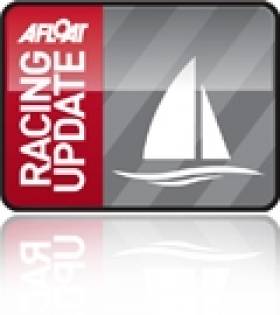Displaying items by tag: Tuskar
Beating towards Fastnet Rock in Normandy Channel Race
It’s been a studious, laborious night for the 20 competitors still out on the offshore race track in the Normandy Channel Race. The SW’ly wind is right on the nose as they continue to battle towards Fastnet Rock after rounding the Tuskar mark yesterday afternoon. Twice the distance, three times the effort it is often said. Indeed, the Class 40s are embroiled in a series of tedious tacks upwind in a bid to make even minimal headway, with a heavy price to pay in terms of physical effort and strategic cogitation, with every sail manœuvre requiring a serious amount of stacking, which consists of shifting any movable weight in the boat to the other tack, from heavy sail bags to personal belongings. However, a sailor has a sense of humour and also knows a thing or two about philosophising, as evidenced by this short message from Halvard Mabire (Campagne de France) last night: “The work on deck is quite a laugh, but the shifting of gear down below is no joke, especially whilst the floor is constantly jumping around and moving. It’s easy to keep hitting yourself against the walls and bulkheads and taking a bath is out of the question, otherwise you’re at risk of setting the tongues wagging on the dock (because it’s common knowledge that nobody believes you if you say you’ve walked into a door to explain a black eye...)”.
After a quick exit from the English Channel and an ultra fast climb up to Tuskar, the race pace has dropped off considerably and the ability to make headway has greatly reduced. A firm leader, Imerys (Phil Sharp - Pablo Santurde), which has consolidated its lead overnight, (over 13 miles) has only covered 89 miles in the space of 24 hours in reality, or an average speed of less than 4 knots. The British-Spanish pairing is just 20 miles or so from the famous rock this morning, which it is likely to round late morning, before linking onto a rapid negotiation of the Irish Sea, beam onto what is set to be a W’ly wind. As is often the case, beating tends to reshuffle the cards and behind Imerys the battle for the top spots is fierce. Gambling hard, V and B (Sorel-Carpentier) has sacrificed her second place to hunt down a little more pressure a long way South, and with it a decent wind angle that will enable her to drive straight down towards Fastnet and hopefully be in with a chance of getting the better of Serenis Consulting (Galfione- Troussel).
With the passage shortly after 02:00 GMT this morning of Team SPM (Bry-Day), all the protagonists have now rounded the Tuskar mark and are making for Fastnet.
Double-handers head for Tuskar
A fleet of top-class double-handers will streak across Ireland's south coast in the next two days as part of a 1,000-mile race beginning and ending in the French port of Caen. The Normandy Race sends the crews of Class 40s around the Tuskar rock and then on to round the Fastnet to Port before heading back toward France. The fleet has already navigated through the Solent, and in second position is a team including Michael Kleinjans, who set the Round Ireland single-handed record in his Class 40, Roaring 40.
The race can be followed online with the real-time tracker.

























































